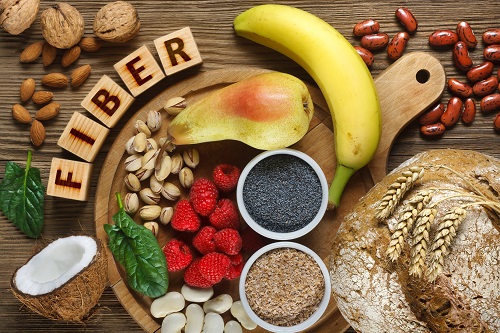Fiber is widely known that it is a component that is beneficial for health, but the specific effects of it may not be well known. In this article, we will explain in detail the classification and functions of it.
●First of all, what is fiber?
Carbohydrates, lipids, and proteins are often called the three major nutrients, essential for building the human body and providing energy. However, not all carbohydrates act as an energy source. Some, known as fiber, can’t be digested by human enzymes.
Carbohydrates that can be digested are classified as sugars. These provide about 4 kcal of energy per gram and are vital for tissues that rely solely on glucose for fuel, like the brain, nervous system, and red blood cells.
Fiber, on the other hand, produces only a small amount of energy when fermented by gut bacteria. That’s why, when we talk about carbohydrates as a major nutrient, we’re generally referring to sugars, not fiber.
For a long time, it was dismissed as a “non-nutrient” due to its lack of direct energy provision. However, extensive research has since unveiled its crucial role in health. Studies consistently demonstrate that higher it intake significantly lowers the risk of serious conditions like stroke, type 2 diabetes, and certain cancers.
Today, fiber is recognized as an indispensable nutrient for overall well-being.
●The functions of “soluble” and “insoluble” fiber
Fiber isn’t a single entity; it’s broadly categorized into two types based on how they interact with water: soluble fiber, which dissolves, and insoluble fiber, which does not. While both types journey undigested to your large intestine, their effects on your body are quite distinct.
Soluble fiber dissolves in water and forms a gel-like substance. This gelling action slows down the digestion and absorption of sugars, helping to prevent sharp spikes in blood sugar. It also plays a role in reducing the absorption of unwanted cholesterol and sodium.
Furthermore, this gel increases the water content of your stool, making it bulkier and promoting smoother bowel movements.
Insoluble fiber, conversely, doesn’t dissolve. Instead, it stimulates the mucous membrane of the large intestine, encouraging the secretion of water and mucus. This process increases stool bulk and softens it, which can be beneficial for relieving constipation.
However, for individuals with irritable bowel syndrome (IBS), it might actually worsen symptoms. If you’re using fiber to manage constipation, it’s crucial to observe how your body responds to ensure it’s the right fit for you.
●Pay attention to fermentable fiber that supports intestinal health!!
In recent years, the classification of fiber has expanded beyond just solubility. Now, whether it’s easily fermented by gut bacteria is also drawing significant attention. This type is called fermentable fiber. It includes soluble fibers like beta-glucan and pectin, some insoluble fibers such as hemicellulose, and even resistant starch.
When the beneficial bacteria in your gut ferment and break down these fibers, they produce beneficial acids called short-chain fatty acids (SCFAs). These SCFAs are crucial for gut health; they help suppress the growth of harmful bacteria and strengthen the gut’s barrier function.
There’s even research suggesting that fermentable fiber might help prevent obesity. For instance, a mouse study found that consuming highly fermentable, low-molecular-weight “beta-glucan” (found in barley) increased SCFA production, potentially improving sugar and lipid metabolism.
Given the diverse functions of fiber, consuming a balanced mix of all types is key. According to Japan’s “Dietary Reference Intakes (2020 edition),” adults aged 18-64 should aim for at least 21g of it daily for men and 18g for women.
However, the National Health and Nutrition Survey indicates that many modern individuals aren’t meeting these targets, with men in their 30s consuming an average of 18.3g and women 15.9g.
To hit your daily it goals, it’s essential to consciously include fiber-rich foods in your diet. Barley, for example, is an excellent choice as it’s packed with both soluble and insoluble fiber, making it ideal for boosting your intake. For delicious ways to incorporate barley into your meals, check out link below.
The original article:
水溶性食物繊維と不溶性食物繊維は、どう違う?|食べるからだメンテナンス|おいしい大麦研究所


